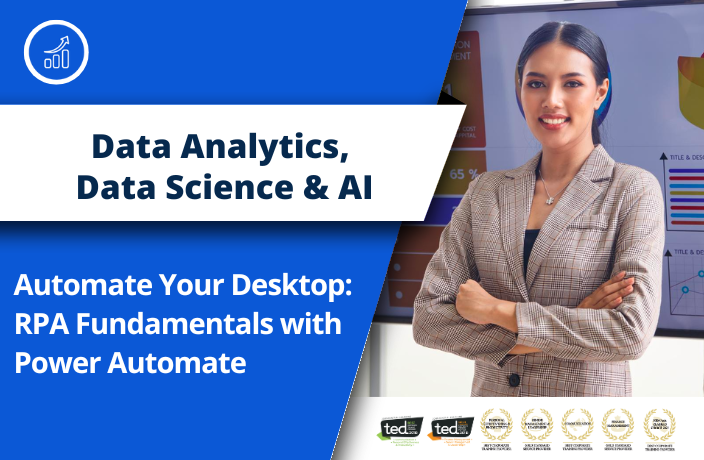Automate Your Desktop: RPA Fundamentals with Power Automate

Course Information
| Status | Pre-confirm |
| Start Date | 11 Mar 2026, Wed |
| Start Date | |
| End Date | 12 Mar 2026, Thu |
| Time | 9.00am to 5.00pm |
| Mode | |
| Fee | SGD 1,280.00 (excluding GST) |
| Contact | Eunice | 6720 3333 | training.aventis@gmail.com |
| Register Now | |
| Get In-House Quotation | |
-
Overview
-
Learning Outcomes
-
Who Should Attend
-
Testimonials
-
Trainer's Profile
-
Course Outline
Designed as an introduction to the fundamentals of robotic process automation (RPA) using Microsoft Power Automate Desktop. Explore how to automate repetitive desktop tasks, interact with legacy systems, and streamline workflows, all without the need for complex coding. Learn key concepts such as UI automation, data extraction, conditional logic, and error handling, which will give the essential skills to begin building desktop automation solutions.
- Introduction to RPA and Power Automate Desktop: Understand the basics of robotic process automation and how Power Automate Desktop fits into the Microsoft Power Platform.
- Building Your First Desktop Flow: Create simple automation flows to automate everyday tasks like opening applications, sending emails, or copying files.
- UI Automation Techniques: Learn how to interact with user interfaces, including clicking buttons, entering text, and extracting information from screens.
- Automating Data Entry and Extraction: Extract data from text files, web pages, and applications, and automate data entry into systems.
- Using Conditions, Loops, and Logic: Apply conditional logic, loops, and control structures to build dynamic and intelligent automations.
- Handling Errors and Exceptions: Implement basic error handling to ensure automations run smoothly and can recover from unexpected issues.
This course is intended for
- Business professionals looking to automate repetitive desktop tasks and improve productivity without needing programming expertise
- IT staff who want to understand and support automation initiatives within their department
Pre-requisites
· Has completed A Beginner's Guide To Automation with Power Apps and Power Automate course – ESSENTIAL REQUIREMENT.
· Participants are required to bring their own laptop PC for the practical hands-on portions of the workshop – Note: Power Automate Desktop does NOT work on MacOS or Linux.
· Participants will require access to Power Apps, Power Automate, Outlook Email and SharePoint through licenses in their corporate/enterprise Microsoft 365 accounts.
"His patience is truly commendable. The hands-on practicum section in this workshop was particularly valuable and practical. Overall, a great and highly useful course"
-Mohd Khairudin Bin Mohd Ali, Singapore Prisons Service (2024)
"The trainer is informative, engaging, and interactive. The section on how Power Automate and Power Apps integrate together was especially useful and insightful during the workshop"
-Lai Yee Han, Illumina Singapore (2023)

Peter Goh embarked on his illustrious teaching journey in 1990, assuming the role of an IT Instructor in secondary schools. His commitment to education led him to serve at Tanjong Katong Girls' School and subsequently Anderson Secondary School, where he imparted fundamental IT and internet skills to students. Throughout his evolving career, Peter has donned multiple hats in the IT domain, holding positions such as Systems Administrator, Programmer, Systems Architect, IT Project Manager, and Chief Technology Officer.
Peter's extensive expertise is underscored by a plethora of certifications, including Certified Scrum Product Owner (CSPO) and Certified Scrum Master (CSM) from the Scrum Alliance, Certified Cloud Practitioner from Amazon Web Services (AWS), and Certified Azure Fundamentals from Microsoft. Additionally, he boasts a WSQ ACTA certification, demonstrating his prowess as a trainer.
Demonstrating his prowess as a seasoned developer, Peter has contributed to diverse projects for prominent entities like the Peoples' Association and ST Engineering, as well as small to medium-sized businesses such as Fancl, Olam, Heinz, Watsons, KBox, and Sakae Sushi. His portfolio encompasses the development of web-based applications and native mobile apps for both Android and iOS platforms. Leveraging his proficiency, Peter has also conducted training sessions on various programming languages, including Java, C#, Swift, Angular, React, and Flutter, along with courses on systems and cloud topics. He imparts knowledge at Authorized Training Organizations (ATOs) and serves as an adjunct faculty member at Ngee Ann Polytechnic.
Day 1
· Introduction to RPA and Power Automate Desktop
· What is Robotic Process Automation (RPA)?
· Benefits and use cases of RPA in business
· Overview of Microsoft Power Platform and where Power Automate Desktop fits in
· Key components of Power Automate Desktop
· Navigating the Power Automate Desktop interface
· Building Your First Desktop Flow
· Creating and running your first automation flow
· Understanding actions, and sub-flows
· Automating simple tasks: launching apps, sending emails, file operations
· Saving and organizing flows
· UI Automation Techniques
· Introduction to UI elements and selectors
· Recording and editing UI automation
· Simulating clicks, key presses, and navigation
· Extracting text and data from UI elements
· Best practices for reliable UI automation
Day 2
· Automating Data Entry and Extraction
· Reading and writing data from/to Excel, text files, and CSVs
· Web data extraction using UI automation
· Automating repetitive data entry tasks in forms or legacy apps
· Combining data sources within a flow
· Using Loops to Process Repeated Tasks
· Loop types: For Each, Loop Condition, Loop Number of Times
· Automating actions over lists, files, or table rows
· Combining loops with conditions for intelligent iteration
· Applying Conditions in Automation
· Introduction to conditional logic: If, Else, and Switch actions
· Creating decision-based flows
· Using Boolean conditions, comparisons, and logical operators
· Handling Errors and Exceptions
· Understanding why and how flows fail
· Using Try-Catch blocks and On Error actions
· Logging and notifying errors via email or logs
· Designing resilient and recoverable flows
